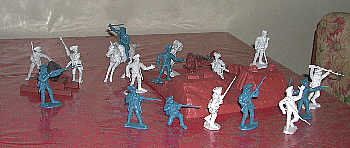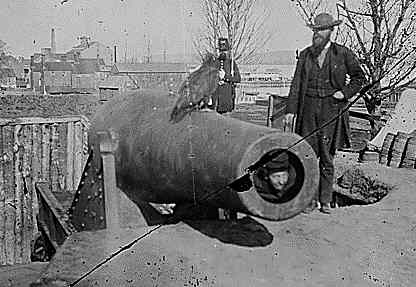

One of the most popular kinds of playsets was the historical variety. After all, it's America in the late 1950s, there are movies and TV shows about the Alamo, Davy Crockett, Daniel Boone, cavalry, Indians and cowboys. In history classes, kids learned about George Washington, Abraham Lincoln, Manifest Destiny, the Civil War and America's westward expansion. Put them all together and you have a winning package. From New York to California, Alaska to Key West, it was all common knowledge to the average American school kid.
The American Revolution playsets sold by Marx and its competitors were as likely to be sold to schools as to children. Many a class had a clumsy diorama built around such a playset. The set itself generally included American troops in blue, British redcoats, a few cannons, and perhaps a small fort or blockhouse. Marx's included quite a fort - many parts were the very same as Fort Apache's. The Revolution was re-issued as johnny Tremaine after a popular show. Lido and a few others produced their Revolutionary troops. In some cases, it was a matter of using the same molds for both Blue and red troops. Others like marx had very different figures for each side. The kids din't care. All we wanted was to fight one of those battles heard in history class: Bunker Hill, Trenton or Yorktown.
As playsets go, the two most popular of all time were the Alamo and Fort Apache. Marx was first to launch an Alamo set, following a popular movie and series by Disney. Davy Crockett was a household word then; raccoon hats were selling like hotcakes in toy stores. We all had them. Little kids ran through the neighborhood with funny fur hats and raccoon tails - perhaps resembling a migration of marsupials more than an imitation of historical figures.
The Alamo set went through many permutations. It came complete with Texans and frontiersmen, mexicans and indians. Yes, Indians - maybe not good history, but good playtime! And the Mexicans had many uses. An Alamo set was both a fort and a place to play Zorro. Because so many of the troops were molded in blue shades, they often ended up mixed with Civil War soldiers.
Marx's Blue and Gray battle set remained one of their best sellers. It came with union and Confederate troops, caissons, artillery, cavalry, and even a stone bridge and burned-out southern mansion. It was reissued again and again, sometimes with a different name. Gettysburg was one such reissue. For the hundredth anniversary of that battle, Marx produced a new set of additional troops in new poses.
For kids, the Blue and Gray battle set was simple. One side was blue, the other was gray. History wasn't the point any more. Here were two evenly-matched toy armies all boxed up and ready to go. MPC quickly added its own playset with those annoying ring-hand figures, while Lido and others cranked out bags of Civil War figures. Marx took care that Confederate and Union troops were different figures as well as different colors, but MPC, Lido and Tim Mee just molded the same figures in both colors.
A peculiarity of the Civil War sets was their appeal in both North and South. In fact, I remember occasions where a Civil war playset could be an icebreaker when Northern kids met their Southern counterparts. One particular time was when a family from North Carolina moved into the neighborhood. One of us had a Civil War playset out the day we met our new friends. It was instant commonality. Our new friends were as adept with the game as us, and in no time we had set up a fine battlefield. They instinctively chose the gray troops - which saved the usual debate of who gets which side. I don't remember if the particular set was Marx or MPC, but it was a great icebreaker.
And therein is the irony - that a war which had divided a country provided the tool that united kids a hundred years later. Since starting this website, I've heard from folks on both sides of the Mason-Dixon line who report similar incidents. So it was that on a warm summer day in `62, the new kids from North Carolina could settle right into their new neighborhood.
Competing with the Alamo for all-time favorite was Fort Apache, a Western fort which pitted settlers and soldiers against indians. Fort Apache was the most enduring set, and versions include an early one with tin-litho walls, the common snap-together plastic version ,and a later tin-litho carry-case that turned into a fort. Fort Apache's defenders changed, too. In the version I had, they included Boonesboro settlers and a few cavalrymen. Later versions had newer cavalry figures. The fort came with accessories like a well, teepees, campfire, totem pole and some of the best Indian figures ever made. Strangely enough, amid all the Plains Indians was one Iroquois straight out of 1765.
Westerns were big in the 50s and early 60s, so Fort Apache was a natural winner with children. We could play everything from Wild West shoot-em-up to Apache raid without skipping a beat. And the Fort could also host a Civil War or Revolutionary battle just by using different troops. No wonder so many makers offered their own versions of the Western wood fort.
TV, movies and history class might have reinforced our youthful interest in these grand playsets. In a way, they were the TV toys of their day. Marx had produced a Rin Tin Tin version of Fort Apache, a Johnny Tremaine version of the Revolutionary set, and a few revisions of its Civil War set. Recently, BMC has issued new sets that recreate this historical era. All they need now is a fort of their own.

Even back then, every artillery unit had some duds.
What's Out There
Marx has reissued its Fort Apache and Alamo sets. Fort Apache is available in a collector's tin litho version, and the more familiar snap-together plastic fort. Red Boxx makes its own Fort Buffalo, a wooden fort defended by cloned Airfix Cowboys and assailed by cloned Airfix Indians. BMC makes a less substantial Alamo fort which is well-supplied with troops and accessories. The BMC "Yorktown" set is a plainer Revolution, with four cannon bunkers, a couple of mounted generals, and an assortment of American, British, French and Hessian soldiers. The BMC Civil War set has a couple of buildings and caissons with cannon to accompany gray and blue troops; The Battle of the Little Bighorn has a rather large Indian village in lieu of a fort. I have yet to see bags of Alamo, Civil War or Revolutionary War soldiers in the stores these days. Apparently, history doesn't sell as well in these 'politically correct' times.
Click here to return to Main Page
Click here to see photos of Army Men and other toy figures
Battle of Queensland, War of 1812
Click here to find out how you can help make this site better!